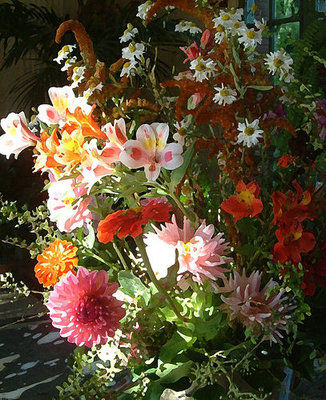A gardener’s life: water, prune, plant, rake, weed, stake. Repeat as necessary. Then smell the roses, harvest the vegetables and pick a mixed bouquet of flowers, grasses and greens to enjoy inside.
It’s great to be out in the garden among your beautiful plants. Reward yourself and take the outside in.
Have you ever seen the spectacular arrangements made weekly for the mansion at Filoli Gardens in Woodside? They are truly breathtaking, composed of whatever plants and flowers happen to catch the eye of the harvester. You can have this, too, for your own dining room table, kitchen, bedroom or bath.
Until about 100 years ago, one of the most important areas of any large garden was the cutting garden, where flowers were harvested like a crop and taken inside for display. Today, our lifestyles and tastes are reflected in bouquets that are more casual. The bouquets you make from garden-grown flowers, interesting foliage branches, grasses, vines and even herbs always seem to have more personality and cottage-garden softness than bouquets bought from the store.
While just about any plant material that strikes your fancy will work in a mixed bouquet, there are four types of plant forms that naturally look good together: Spires for their height and architectural properties (liatris, snapdragons, gladiola, salvia, bells of Ireland). Round blooms for focus (roses, dahlias, long-stemmed marigolds, peonies). Lacy shapes for fillers (ferns, baby’s breath, dill). Foliage (abelia, breath of heaven, California bay), and ornamental grasses.
An unexpected touch
Here are some unsung beauties to grow and add to your arrangements.
n Love-lies-bleeding (Amaranthus caudatus) has pendulous ropes of red flower clusters up to 18 inches long. These are handsome mixed with bold companions, like zinnias and sunflowers. It makes a good dried flower.
n Bells of Ireland (Moluccela laevis) are showy, with long-lasting apple green flower spikes that shine in either fresh or dried arrangements.
n Transvaal daisy (Gebera jamesonii) has perennial, long-stemmed varieties that bloom nearly year round, with peaks in early summer and late fall. They make a prized cut flower. For long vase life, split the stem end, dip it in boiling water and stand the bloom in deep water.
n Lisianthus is a perennial grown as an annual. The flowers resemble roses in shades of purplish-blue, pink and white. They bloom all summer on strong stalks.
n Pink muhly grass (Muhlenbergia capillaris) has airy plumes of feathery, deep rosy-pink flowers on tall stems and is drought-tolerant.
There are so many plants to use in bouquets. Don’t forget — grapes and other vines, herbs, woody tree branches and shrub foliage look great, too.
The perfect cut
The best time to cut is early in the morning. Slice across non-woody stems on a slant for maximum water absorption. Cut woody stems straight across and smash the ends. Then plunge them immediately in a bucket of tepid water. Indoors, fill the kitchen sink with cool water and re-cut each stem underwater so an air bubble won’t keep the water from being absorbed.
Pull off any foliage or flowers that will be below the water level in the vase, and fill the vase with lukewarm water. You can add cut-flower food, but I find that changing the water every two days and making sure no foliage is underwater works just as well.
If a plant isn’t working out or is spent in your arrangement, just remove it. The main thing is to have a garden that you love both inside and out.
Jan Nelson, a California certified nursery professional at Plant Works in Ben Lomond, will answer questions about gardening in the Santa Cruz Mountains. E-mail her at ja******@*ol.com.












